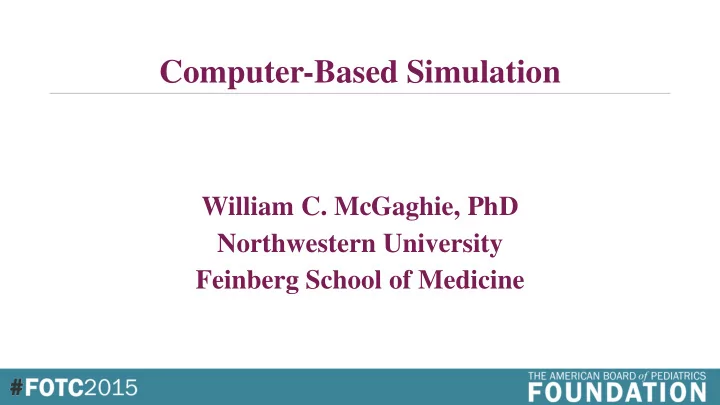

Computer-Based Simulation William C. McGaghie, PhD Northwestern University Feinberg School of Medicine
Computer-Based Simulation Definition “This testing format . . . requires the examinee to manage a simulated patient in simulated time. The examinee can select options for history-taking and physical examination. Diagnostic studies and treatment are ordered via free-text entry, and the examinee controls the advance of simulated time and the location of the patient in the health care setting.” Dillon & Clauser (2009)
Computer-Based Simulation Key Issues “. . . selecting an assessment method involves [attention to purpose and] context-dependent compromises.” (van der Vleuten & Schuwirth, 2005) Reliability depends on sampling: content, judges, instruments, contexts Validity: authenticity and integration of competencies Educational impact
Computer-Based Simulation Pro s Fidelity – clinical realism Engaging Assess: ● Diagnostic decision-making skills ● Therapeutic intervention skills ● Developing and implementing a patient management plan 20 + year NBME research legacy
Computer-Based Simulation Con s Scoring is difficult USMLE Step 3: 9 CCS, 25 min/CCS ≈ 4 hrs Less efficient than MCQs per unit of testing time
Computer-Based Simulation Costs • MCQs are more cost-effective • Complex software and large database needed to support real-time delivery of the CCS test format • Test delivery can be challenging • Accurate and timely reporting of results is difficult
Computer-Based Simulation Risks • Continuous test administration throughout the year • Small case pool due to effort required for case development • Examination security can be compromised via examinee grapevine
Computer-Based Simulation Feasibility “. . . increased complexity in testing format results in a reduction of the number of times the examiner is able to assess the examinee, per unit of testing time. Without an increase in test length and time, a loss in score precision should be expected and, again, this likely outcome needs to be carefully measured against the value added by the simulation format.” Dillon & Clauser (2009)
Computer-Based Simulation References Dillon GF, Clauser BE. Computer-delivered patient simulations in the United States Medical Licensing Examination. Simulation in Healthcare 2009; 4: 30-34 Van der Vleuten CPM, Schuwirth LT. Assessing professional competence: from methods to programmes. Medical Education 2005; 39: 309-317.
Recommend
More recommend